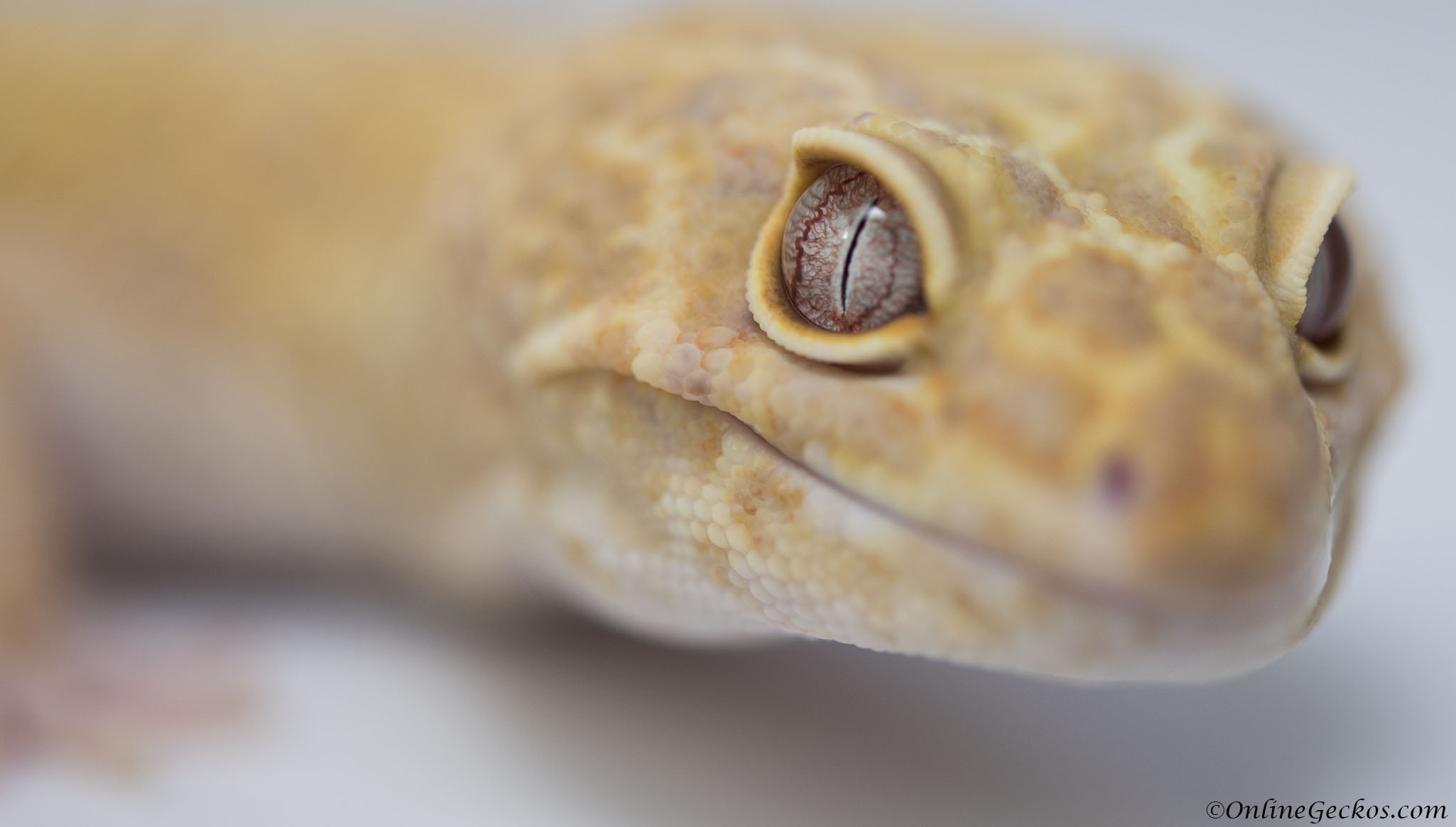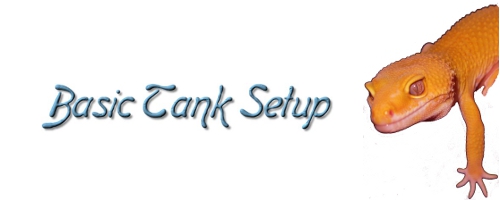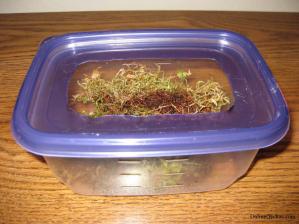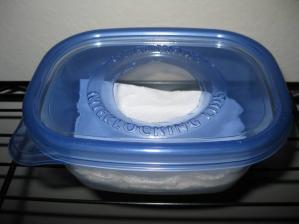

We've been asked before to show a basic leopard gecko terrarium setup, something to give new hobbyists a visual idea of how their tanks should look like. So here's an example of one of our leopard gecko tanks, newly built to house one of our future breeders. We built it with 3 simple things in mind:
1. Safety - Using slate/ceramic tiles, there is zero impaction risk. Unlike sand and other loose substrate, tiles won't get ingested by geckos. Too often people mistaken leopard geckos with other sand lizards. Leopard geckos are arid creatures, they do not live in sand, they actually live in rock crevices and burrows. So slate/ceramic tiles would feel more natural to them than sand substrate. Also make sure there is nothing too tall that can allow them to fall hard onto the ground. Leopard geckos do not have sticky pads on their toes (unlike crested geckos), so you want them to be able to reach down to the ground from the highest point of your decorations. Never design a cliff because they often will take the hard way down even if you have a ramp. Falling on their stomach, it could cause internal bleeding and possibly death.
Those utilizing loose substrate such as Eco Earth Coconut Fiber throughout the whole tank should reconsider. Not only do they pose impaction risk, they will raise the humidity inside the tank above safety levels. High persistent humidity will cause upper respiratory infection in leopard geckos. Leopard geckos only require 20%-40% humidity. Coconut fiber should only be used within the moisthide, this way humidity is controlled, and it lessens the impaction risk because your gecko won't be feeding inside the moisthide. So while we highly recommend Eco Earth coconut fiber as moisthide substrate, we do not recommend using it as the general tank substrate throughout the whole tank.
2. Cleanliness - Slate/ceramic tiles are easy to spot clean, so it's very easy to keep their environment clean. They also last forever. Sand and even repti carpet can trap bacteria, it's very hard to keep their environment clean when those substrate are designed to hide away the mess. Paper towels are often used as a temporary substrate, they work very well since you can simply replace the paper towels when they get dirty.
3. Coziness - Having plenty of hides will allow your leopard gecko to feel safe and secure, which in turn gives them less stress. They can choose where they want to lay in, they can also thermoregulate their own body temperature. This is why there is a warm hide above the under tank heating pad, a cool hide on the opposite side, and a moisthide somewhere in the middle. You want your gecko to feel comfortable, it's a place they'll be living in for a very long time. While these tanks won't be winning any beauty awards (we basically used what we had available at the time), they are designed with leopard gecko's well-being in mind.
First we bought a 20 gallon long tank (30x12x12), and stuck the Zoo Med Repti Therm Under Tank Heating pad to it. Remember UTH (Under Tank Heating pad) is very important for leopard geckos as they require belly heat to properly digest food. The UTH should cover 1/3 of your tank. Zoo Med Repti Therm is a popular under tank heating pad brand.
If you have any questions regarding leopard gecko belly heating or the usage of under tank heating pads, please read our comprehensive leopard gecko temperature/under tank heating guide. It contains detailed information on why leopard geckos require belly heating, how to install UTH properly, and why it's a good idea to use a digital thermostat such as Hydrofarm's Jump Start MTPRTC Digital Thermostat.
Continue on with setting up this leopard gecko habitat, we lay a couple layers of paper towels on the bottom of the tank. The plan is to lay slate tiles on top of them.
Once the paper towels are laid, we start putting the slate tiles on top of them. These are your basic 12x12 multi-colored slate tiles that you can purchase in local home improvement stores. They fit perfectly inside this 20 gallon 30x12x12 tank.
We lay two 12x12 slate tiles down, and cut a piece of 6x12 Zilla Terrarium Liner Repti Carpet to fit the leftover space. We will be utilizing the carpet space as the designated "cool hide". We have found that our leopard geckos appreciate a soft surface cool hide. If you prefer, you can simply get 6x6 tiles to fit the left over space. Or simply fill it with paper towels, rocks (nothing too small), or decor.
Now use your imagination to fit hides and terrarium decorations. Here's an example of what we came up with.
To explain what everything is, we numbered them.
1. Cool hide (Fluker's Castle Crib Reptile Basking Platform), it sits on top of the repti carpet, providing the gecko a soft surface to lay on. We like this particular hide because it also serves as the water bowl. It's a great 2-in-1 design. The size of it is perfect as you can see, it fits perfectly inside a 30x12x12 tank.
2. Cool hide, a terrarium decoration that allows the leopard gecko to climb on. We've used this one in another tank before and the gecko loved to climb up and down through it.
3. Moist hide (Zoo Med Reptile Shelter 3-in-1), purchased online. It's designed to be a moist hide, as well as a laybox for when a female gets gravid later. The Exo Terra Gecko Cave hide will also work very well here, we've used it before and liked it. Note the positioning of this moist hide, it sits in the middle of the tank so it's not too hot but also not too cold. Some prefer to place the moist hide on the warm side directly above the UTH hot spot. That's ok as well, just remember your moist hide will dry up faster if you have the whole hide on the hot spot. The positioning is really a personal preference thing. Just as long as the moist hide sits on spots that are warm, you should be fine. Geckos don't like cold and wet spots as much, especially in captivity where their environment is kept temperate. So make sure you pick a warm surface to sit the moist hide on.
What we like to do is to sit roughly 1/4 of the moist-hide on a warm spot. This way the hide will not get too warm, but it'll get warm enough to keep the moist-hide humid. Popular moisthide substrate are Zoo Med Eco Earth Coconut Fiber (especially good for gravid females), and plain wet paper towels.
4. Warm hide, we like to use warm hides with a flat surface on top. We've noticed leopard geckos sometimes prefer to lay on top of warm hides rather than inside it, possibly due to the heat being too hot on the inside at times. This hide gives the leopard gecko the choice to lay inside or outside on the top. This also increase your surface space, as you are utilizing the same footprint but double the surface space. We really like using Zilla Decor Rock Lair, geckos really seem to like them.
5. Calcium without D3 inside a bottle cap. This is optional, but a common practice. You can find calcium without D3 in any pet stores or via online retailers. Leopard geckos will lick the calcium powder when they want/need calcium. Read our comprehensive leopard gecko multivitamin supplement guide for full details on how to supplement your geckos.
6. A mealworm/superworm safe food dish. You can purchase this from many online pet supplies retailers. It's designed so mealworms can not climb out, and we've been using this here at OnlineGeckos.com and highly recommend it. We've also found these new OMEM Ceramics Made Mealworm Escape-proof Dishes, they are ceramics made, smooth, and the inwardly curved walls are specifically designed to be mealworms/superworms/dubia roaches escape-proof. We recommend them if you prefer a ceramic dish instead of plastic.
Don't forget you will need a water dish if you don't have a hide you can fill water with. These Exo Terra water dishes are really nice because its nonporous surface prevents bacteria buildup and absorption.
If you are going to be housing more than 1 gecko in the same tank, you need to double up on the hides so they can be separated from each other when they want to be left alone. Here is an example of a tank, same 20 gallon long size, that we've setup to house 2 females.
As you can see from the picture above, we have doubled up on the moist hides (one plastic container and one store bought where a gecko is peeking out). There are also two cool hides on the right (wood log and 2-in-1 water/hide). There's also a warm cave on the left, which is large enough for two geckos. We actually have seen one inside and one laying on the top at the same time. So it's another good use of space, this warm hide is perfect. Below is yet another terrarium we've built for one of our female breeders. You can see the use of a gladware container as moisthide/laybox. You don't have to buy anything complicated, these hides work very well.
Here are more leopard gecko tanks to give you more ideas. You'll notice the basics are still there no matter what we use inside these leopard gecko terrariums. Do notice the 4-tier wire shelving system, they are very nice as they allow you to stack 3-4 tanks vertically (AmazonBasics #1 Best Seller 4-Shelf Shelving Unit - Chrome). This will save you room, and keep your living space looking neat and tidy. Let's be honest with ourselves here, once you get into this hobby, you are going to be wanting more than 1 leopard gecko. So you might as well prepare for it!
Of course if you want to go all out, and your budget allows, you could go with an Exo Terra All Glass front-opening terrarium. I can't stress how beautiful these tanks are. Plus they give you easy access when you need to feed the geckos or clean the tank.
Here's a video tour of our gecko room. You can see our tanks setup on the wire shelving system.
All in all, just use your imagination, and have fun with it. Part of the fun is to decorate your leopard gecko's tank. What you see above are not necessarily what you need to do for your terrarium. If budget is tight, you can easily create hides out of deli cups and containers. You can make your own moist hide using a standard plastic container, cut a hole on the lid, and stuff coconut fiber, or paper towels inside.


Good luck, remember to read the leopard gecko care guide for specifics on temperature, feeders, and other leopard gecko needs.
*NEW* Since we've had several requests and inquiries about where we purchased some of the decors and equipment pictured, we're going to be listing them all down below. For those wanting to know where we bought some of our decor and equipment, please see below for a list. We purchased most of them online through Amazon, mainly because things are cheaper there, and they also offer fast free same-day or two-day shipping with Amazon Prime.
We've found that by purchasing from Amazon, you skip the retail markup from retail stores. The same Zoo Med Repti Therm under tank heating pad cost around $30 in retail stores. But on Amazon it's only $16, that's half off the retail markup price. Amazon Prime is totally worth it, get your fast free shipping and try your free 30-days membership here. You could cancel the trial before it's up and pay absolutely nothing, all the while enjoying the benefits of Prime membership such as fast 1-2 days shipping, unlimited video streaming, unlimited Amazon Drive photo storage, and more.
Or if you are a student, you get to try Amazon Prime for 6-months free, and 50% off Prime subscription!
Below you'll find a good portion of the decors pictured in our terrariums.
Under Tank Heating Pad:
Digital thermometer and temperature gun:
Thermostat:
Hides, Layboxes, and Moisthide/Laybox Substrate:
Feeding Dish, Steel Tongs, Water Dish: